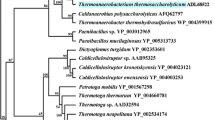Abstract
The xylA gene, coding for xylose isomerase, from the extreme thermophile, Caldanaerobacter subterraneus subsp. yonseiensis was cloned, sequenced, and expressed in Escherichia coli. The nucleotide sequence of the xylA gene encoded a polypeptide of 438 residues with a calculated molecular weight of 50,170 Da. The purified XylA showed high sequence homology (92% identity) with that of Thermoanaerobacter thermohydrosulfuricus. The recombinant enzyme expressed in Escherichia coli was purified by heat treatment and gel chromatography. The purified enzyme was thermostable with optimal activity at 95°C. The enzyme required divalent cations including Zn2+ for its maximal activity and thermostability.


Similar content being viewed by others
References
Antrim RL, Colilla W, Schnyder BJ (1979) Glucose isomerase production of high-fructose syrups. In: Wingard LB (ed) Applied biochemistry and bioengineering. Academic Press, New York, pp 97–155
Bhosale SH, Rao MB, Deshpande VV (1996) Molecular and industrial aspects of glucose isomerase. Microbiol Rev 60:280–300
Brown SH, SjVholm C, Kelly RM (1993) Purification and characterization of a highly thermostable glucose isomerase produced by the extremely thermophilic eubacterium, Thermotoga maritima. Biotechnol Bioeng 41:878–886
Cha J, Cho Y, Whitaker RD, Carrell HL, Glusker JP, Karplus PA, Batt CA (1994) Perturbing the metal site in XylA. Effect of mutations of His-220 on enzyme stability. J Biol Chem 269:2687–2694
Chandrakant P, Bisaria VS (1998) Simultaneous bioconversion of cellulose and hemicellulose to ethanol. Crit Rev Biotechnol 18:295–331
Dekker K, Yamagata H, Sakaguchi K, Ucaka S (1991) Xylose(Glucose) isomerase gene from the thermophile Clostridium thermohydrosulfuricum; cloning, sequencing, and expression in Escherichia coli. Agric Biol Chem 55:221–227
Dische Z, Borefreund E (1951) A new spectrophotometric method for the detection and determination of keto sugars and trioses. J Biol Chem 192:583–587
Epting KL, Vieille C, Zeikus JG, Kelly RM (2005) Influence of divalent cations on the structural thermostability and thermal inactivation kinetics of class II XylAs. FEBS J 272:1454–1464
Erbeznik M, Dawson KA, Strobel HJ (1998) Cloning and characterization of transcription of xylAB operon in Thermoanacerobacter ethanolicus. J Bacteriol 18:1103–1109
Fardeau ML, Salinas MB, L’Haridon S, Jeanthon C, Verhé F, Cayol JL, Patel BKC, Garcia JL, Ollivier B (2004) Isolation from oil reservoirs of novel thermophilic anaerobes phylogenetically related to Thermoanaerobacter subterraneus: reassignment of T. subterraneus, Thermoanaerobacter yonseiensis, Thermoanaerobacter tengcongensis and Carboxydibrachium pacificum to Caldanaerobacter subterraneus gen. nov., sp. nov., comb. nov. as four novel subspecies. Int J Syst Evol Microbiol 54:467–474
Goldberg JB, Ohman DE (1984) Cloning and expression in Pseudomonas aeruginosa of a gene involved in the production of alginate. J Bacteriol 158:1115–1121
Hall TA (1990) BioEdit: a user-friendly biological sequence alignment editor and analysis program for Windows 95/98/NT. Nucleic Acids Symp Ser 41:95–98
Kim BC, Grote R, Lee DW, Antranikian G, Pyun YR (2001) Thermoanaerobacter yonseiensis sp. nov., a novel extremely thermophilic, xylose-utilizing bacterium that grows at up to 85°C. Int J Syst Evol Microbiol 51:1539–1548
Kuyper M, Hartog MMP, Toirkens MJ, Almering MJH, Winkler AA, Dijken JPV, Pronk JT (2005) Metabolic engineering of a xylose-isomerase-expressing Saccharomyces cerevisiae strain for rapid anaerobic xylose fermentation. FEMS Yeast Res 5:399–409
Liu SY, Wiegel J, Gherardini FC (1996) Purification and cloning of a thermostable xylose (glucose) isomerase with an acidic pH optimum from Thermoanaerobacterium strain JW/SL-YS 489. J Bacteriol 178:5938–5945
Vieille C, Hess JM, Kelly RM, Zeikus JG (1995) xylA cloning and sequencing and biochemical characterization of XylA from Thermotoga neapolitana. Appl Environ Microbiol 61:1867–1875
Volkin DB, Klibanov AM (1989) Mechanism of thermoinactivation of immobilized glucose isomerase. Biotechnol Bioeng 33:1104–1111
Acknowledgement
This work was supported by the 21C Frontier Microbial Genomics and Application Center Program, Ministry of Education, Science & Technology, Republic of Korea.
Author information
Authors and Affiliations
Corresponding authors
Electronic supplementary material
Below is the link to the electronic supplementary material.
Rights and permissions
About this article
Cite this article
Kim, BC., Yu, S.N., Kim, K.Y. et al. Cloning, expression and characterization of xylose isomerase, XylA, from Caldanaerobacter subterraneus subsp. yonseiensis . Biotechnol Lett 32, 929–933 (2010). https://doi.org/10.1007/s10529-010-0255-3
Received:
Accepted:
Published:
Issue Date:
DOI: https://doi.org/10.1007/s10529-010-0255-3




